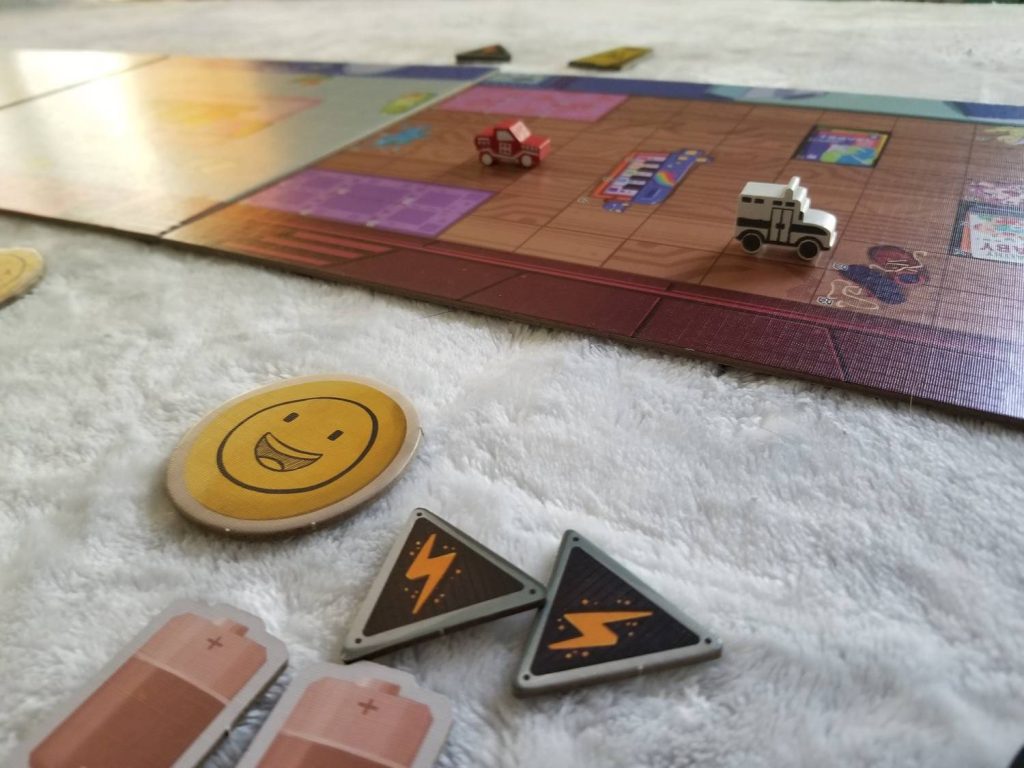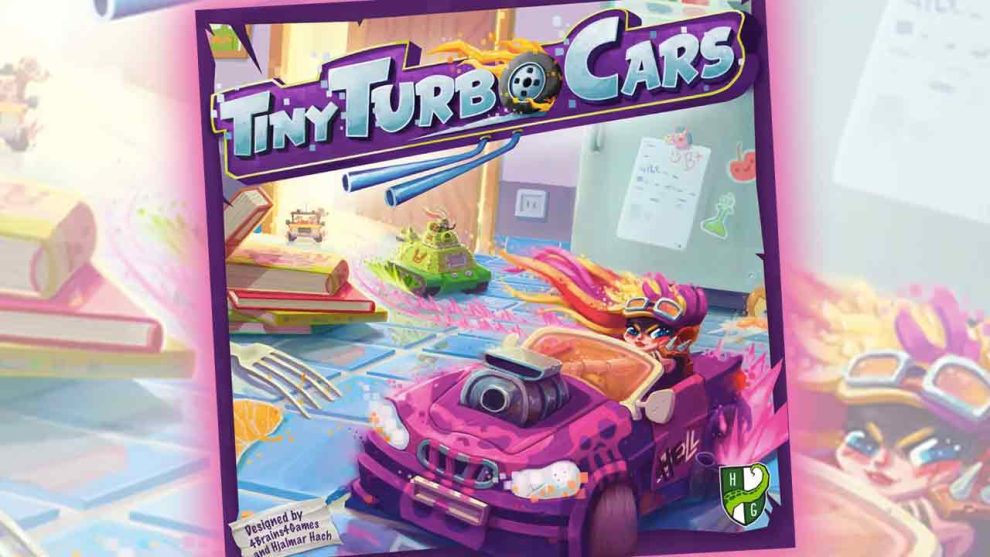Disclosure: Meeple Mountain received a free copy of this product in exchange for an honest, unbiased review. This review is not intended to be an endorsement.
When the parents are away, the kids will play.
In Tiny Turbo Cars, you and up to three of your fellow players take on the roles of children who have decided to turn their ordinary home into an extraordinary RC racing track. Each player controls a different racer with its own unique ability. Each round, using an action programming mechanism (in the form of a sliding puzzle), the players will attempt to move along the course without colliding with the various obstacles (and players) that may get in their way. The first player to cross the finish line wins the game.
Of course, this is an oversimplification. If you’ve heard enough and just want to know what I think, feel free to skip ahead to the Thoughts section. Otherwise, read on as we learn how to play Tiny Turbo Cars.
Racers, Start Your Engines
Here’s how to set up a game of Tiny Turbo Cars:

Gather up the four Track boards. Randomly select three of them and then randomly select a side of each to play on. Place these end to end with the red and blue borders on the same edges. Next, connect the Starting Board to one end and the Finish Line to the other. There are also double-sided, so choose a side for each.
Each player receives a controller (this is the action programming element of the game), three batteries, and a racecar tile (either drafted or assigned randomly, your choice) along with its matching racecar (which I’ll refer to as a ‘racer’ from here on out). After the players have determined a start player, each player places their racer into one of the starting positions, going clockwise from the start player. The Energy Shield and Slippery tokens are placed close by. The Smile tokens are placed next to the play area arranged in a stack with the biggest smile on top and the frowny face on the bottom.
Now, you’re ready to race!
3, 2, 1…GO!
At the start of a round, each player flips their controller upside down, randomly shuffles the sliding tiles around for five to ten seconds, and then passes the controller to the player on their left. Once everyone has received their newly shuffled controller, players turn them face up and start programming. The first player that finishes their programming turns their controller face down and takes the topmost Smile token. The second player to finish does likewise. Once the third player finishes and takes their Smile token, the remaining player will have ten more seconds in which to finish their programming. They must take the frowny face.
Then, going in order from biggest smile to frown, the players will execute the commands on the middle two rows on their controller from left to right, upper row to lower row. The person with the frowny face begins their turn with one of their batteries flipped to its used side.
Batteries
Suffering a damage makes you flip a battery over to its used side. Batteries represent a racer’s health: Face up batteries, good; face down batteries, bad. Taking your time to program your move comes at a cost! If a player ever loses all three batteries, then they must ignore the next three commands on their controller in order to refresh their batteries. This rule extends across rounds, too. If a player loses their third battery at the end of one round, for example, then the first three commands of the following round will be ignored.
Commands
The commands in the game are pretty straightforward, with easy-to-understand iconography. They come in several flavors:
– Red/blue arrows: move diagonally toward the matching colored wall a number of times equal to the number of arrows.
– Forward/backward arrows: move forward or backward a number of times equal to the number of arrows.
– Jump: move forward two spaces, but the first space is ignored.
– Turbo: move forward a number of spaces equal to the number of face up batteries that you have.
– Increase/decrease the next command in line by one.
– Fire a rocket in a straight line and then move forward a single space. Any racers in the path of that rocket suffer a damage and must turn a face up battery to its opposite side.
– Flip a battery face up
– Do nothing/blank

Movement
There are a few rules that come into play as racers move along the course:
– During a player’s movement, if they collide into an immovable object, their current movement action comes to an end and they suffer a damage.
– If they collide with an obstacle or another player, after moving into the space, their current movement action comes to an end and they suffer a damage.
– If their movement begins on a carpeted space, that movement action is reduced to exactly one.
– If a player’s action begins with that player’s racer on a crayon speeder space, they treat the action as if the ‘increase the next command’ action had been used.
– If a water puddle is encountered during a player’s movement, they receive the Slippery token and red arrows are then treated as blue and vice versa.
At the end of a round, if nobody has crossed the finish line, then each player receives one Energy Shield for each racer ahead of them on the track. These can be traded in during the next round to either avoid a damage or for two extra forward movements at the end of the round. However, if the finish line has been crossed, the player that is furthest beyond the finish line wins the game.
Thoughts
Writing for Meeple Mountain is an act of love. Ask any of our talented writers and they’ll tell you the same. We write because we’re passionate about the hobby and have a compulsion, a need, to share that passion with the world. And there are a lot of us. That’s why, when a review copy request comes in, sometimes you have to act quickly with very little information to go on. Does the theme appeal to me? What’s the minimum player count? Who designed it? Does it look good? How likely am I to get it played based on these factors?
When the request came through to review Tiny Turbo Cars, it came in the form of a press release packet. Looking over the information we were provided, I liked what I saw. Hjalmar Hach, designer of hits such as Dragon Castle, Photosynthesis, and Railroad Ink? Yes, please. 30-45 minute play time? Able to accommodate 2 to 4 players? So far, so good.
And a cheeky theme about racing RC cars through a makeshift racing track? With player boards that look like little remote controls? Using a sliding puzzle mechanism to program the actions?!
SQUEE.

It looked and sounded like it was going to be a lot of fun, so I didn’t just toss my name into the hat. I unleashed my inner Michael Jordan and slam dunked it. And then I waited.
When Tiny Turbo Cars finally arrived, I tore into it like it was a bag of cat food and I was a cat that could clearly see the bottom of my food dish. And I was not disappointed.
The press release photos didn’t do the components justice. Everything is bright and chunky and a pleasure to hold in your hands. And it’s all packed into the box so neatly. A little too neatly, if I’m being honest. There are a few components that fit into their spots so snugly that it’s difficult to pry them out.
The player boards as plastic RC controllers are super cool. They’re like nothing I’ve ever seen in a board game before. The idea of using a sliding puzzle to program the actions is inspired. Genius even.
It’s just too bad that it doesn’t work.
Typically, it’s the gameplay that tanks a game, but that isn’t the case here. The actual mechanics of moving your racer across the floor are sound. The tension created by the encroaching shadow of the time limit is delightful. The fact that the time limit is controlled by the players is an ingenious concept. A game with slower players moves by at an acceptable pace for all the players. A game with faster players forces the slower players to speed up. And even going last has its advantages. There’s even a catch up mechanism for people that have fallen behind! The parts of this game that work, work very well.
No, it isn’t the gameplay that hurts this game. It’s physics.
When you tightly cram a bunch of tiny squares into a frame together with just enough of a gap for one square to move at a time, you get friction. This friction makes it very hard to slide the pieces around. And this is super annoying. It’s so annoying, so grating, in fact, that instead of fostering smiles and excitement, it generates apathy. And that’s not fun for anybody. Each time I’ve played this game, invariably the players just wind up accepting whatever jumbled mess they’ve been given, give it a few half-hearted slides here and there, and call it a day. The very thing about this game that makes it so unique leads to the players simply not caring anymore.
Initially, I thought that maybe the friction caused by sliding the pieces around was due to the game being brand new. “Maybe,” I thought, “the mechanisms will become looser the more they’re used.”
So, I put this theory to the test. I watched some movies.
As I watched those movies, I held a controller in my hands. I slid the pieces back and forth nonstop for hours on end. In this fashion, I hoped to simulate hours worth of non-stop game play. But it didn’t help. After three or four movies, nothing had changed. The sliding pieces in the controller were just as tightly packed and difficult to move as they ever were.
I really wanted this game to work. Maybe if each player were given a bag full of Azul-style tiles (in lieu of the plastic sliding puzzle) and then asked to draw those tiles from the bag to program their turn in real-time, you’d be able to keep the frenetic pace without all the friction and the awkward passing of the controller from person to person. But it is what it is. We’re stuck with these really cool looking controllers that just aren’t very functional. A classic case of a game being too gimmicky for its own good.
Tiny Turbo Cars has a lot of promise, but that promise is never fully realized. But, as they say, your mileage may vary.
Never waste a good racing pun.












Quite the opposite if anything for me the controls are in some cases a little loose in that tiles will freely drop down into your gap so maybe a bit of a QC issue. Not a deal breaker however, having the 6 player version theres plenty of controllers to go around. Played 3×3 player games so far. All fairly chaotic bouncing off walls and a lot of unintentional rear-ending of another players car. Look forward to trying some of the other boards, power-ups etc. Great game for a few beers with friends!